A day after arriving in Copenhagen, Denmark, the weather was quite good. Not knowing what it would be like later that week, I decided to head straight out of the country. I hadn’t been in Sweden since June 2010. Actually Helsingborg is only a nearly one hour train ride to Helsingør (Elsinore) and a rather short boat trip away (with great views on Kronborg castle).
I and my travelling companion on this visit could have been at Sofiero much earlier, if we had taken the right bus (my mistake). Just outside the ferry terminal there are bus stops. DON’T take the one we did. You have to cross the street to catch the right bus no. 8, that by the way goes quite regularly, each 15 minutes and stops at the gates of the castle. Tickets can be bought online via an app. At least we did a tiny bit of sightseeing in Helsingborg by bus and the weather was great.
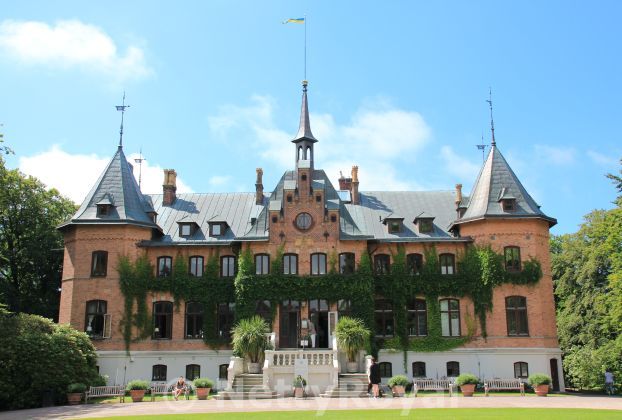
History
In the year 1864 Crown Prince Oscar of Sweden and his wife Sophia bought a Scanian farm called Skabelyckea few kilometres north of Helsingborg. They had a one-story summer residence in Dutch Renaissance style built, with attics and cellars, that was completed in the next year. From the house, that was called Sophie-Ro they could see the Öresund. 1866 was the first summer they spent time in the house. In 1872 Oscar became King Oscar II of Sweden, and between 1874 and 1876 he had his summer palace expanded. The extension meant they could now also receive visitors at the house, and the king could continue working at the palace. They spent many happy summers here, but when they got older and Queen Sophia had health problems, they started visiting less often.
In 1905 the house was the perfect wedding gift for Prince Gustav Adolf, who would later become King Gustav VI Adolf, and his wife Margareta née Princess Margaret of Connaught. They first visited as a couple in July 1905 and were greeted enthusiastically. As the building was in urgent need of being renovated and the gardens were overgrown, there was lots of work to do. Gradually the couple transformed both the house and the gardens. The dark interior was replaced by brighter colours and fashionable floral chintzes.
Both Gustav Adolf and Margareta were very interested in gardening. Together they created the structure as it is still known today. They visited the castle in the summers together with their children Gustav Adolf (1906-1947; the father of the present king Carl XVI Gustaf), Sigvard (1907-2002), Ingrid (1910-2000; who inherited the love for gardening from her parents; mother of the present Queen of Denmark, Margrethe II), Bertil (1912-1997) and Carl Johan (1916-2012). At Sofiero they experienced private family life and could relax, and the children remembered the time spent at Sofiero for the rest of their lifes. Also they had their own plots of the garden and there were playhouses.
In May 1920 Margareta suddenly died. Gustav Adolf continued visiting the castle, that he loved so much, also with his second wife Louise née Lady Louise Mountbatten, who died in 1965. He continued the work on the palace and its gardens. He became King of Sweden in 1950 and died in Helsingborg in 1973. He left Sofiero to the city of Helsingborg, but requested the municipality should keep the gardens in good condition. In 1974 Sofiero opened its doors to the public, and has become a major tourist attraction.
Sofiero is open nowadays from about April to September, for the exact days always check the website. Every pre-summer Gustav VI Adolfs collection of rhododendrons, there are more than 400 different varieties, comes to life and can be visited. It is the world’s most exclusive collection of rhododendrons.
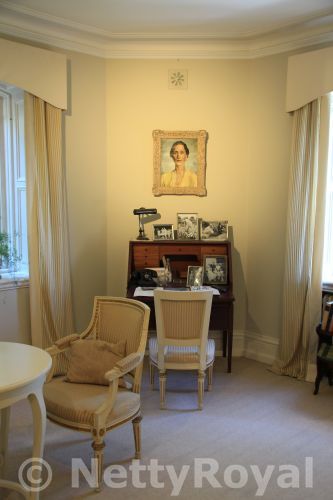
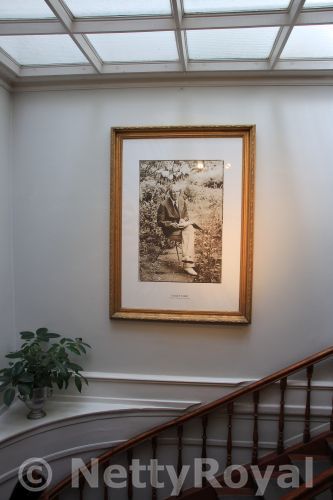
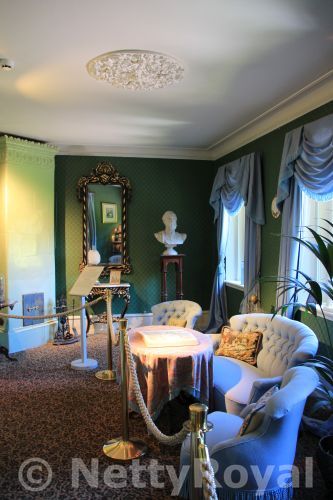
My visit
Sofiero has been long on my wishlist of royal places I would like to see one day (the list is still far too long). So I was quite happy finally getting there, and with such lovely weather too, which is of course the best kind of day for a visit of a castle with a rather huge garden, its size is 17 hectares. As soon as we entered the area we admired a flower bed, which I think was called Queen Silvia’s floral adornment. From there we took the first photos of the castle, and then walked over the large lawn towards the castle to take pictures. It was good we did that, as when we left later that afternoon the light was much worse. We first decided to visit the castle.
Although the castle itself is open, only the top floor is being used for exhibitions. Apart from a permanent exhibition about the royal family at the palace there is also a part used mainly for art exhibitions. Although most of the original furniture today is at the Royal Palace in Stockholm, visitors get an idea how they lived at the castle. The bath room looked rather good, and is better than mine actually. Wonderful are the many photos of the family at Sofiero that are shown in several rooms. And I loved the view from the balcony, although I expect in the past the royals might have had a somewhat better view on the sea.
Downstairs are the Sofiero Castle Restaurant and the Café Glasverandan. When leaving the top floor we sneaked into the restaurant, as I spotted a big bust of King Oscar II. Rather posh, but not yet open. The café however was open, and has a lovely view. One can even sit outside. They offer a good selection of cakes, sandwiches and light lunches. Unfortunately no Swedish Princess Cake (Prinsesstårta), but we found a delicious cake called Silviakake, presumably named after the Queen. I tried one of the tea blends that was offered, some of them with royal names. In the park one can also find The Orangery bistro.
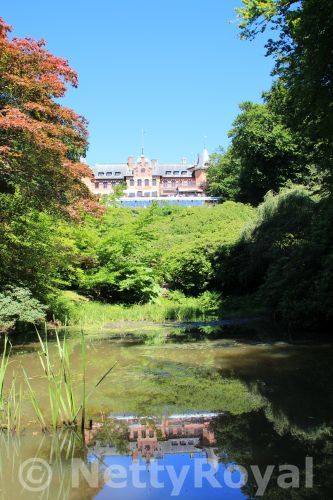

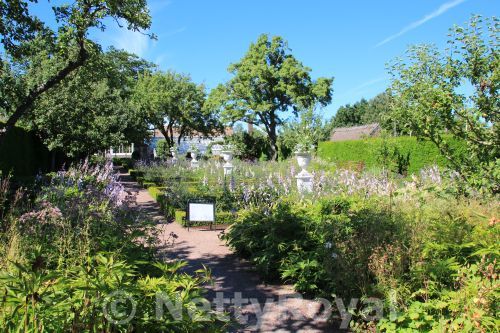
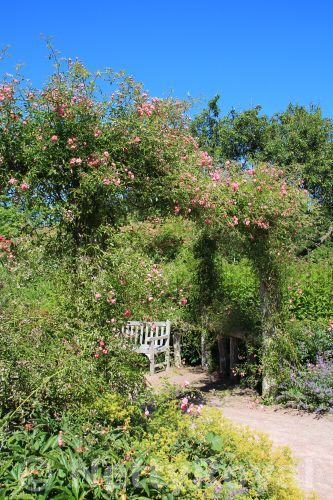
Click on the pictures to enlarge them
No blooming rhododendrons anymore at this time of the year (July 2022), but still the park and gardens looked lovely. We started at the back of the castle, where already soon we noticed Prince Oscar’s Enchanted Forest, a present to Prince Oscar, Duke of Skåne from the City of Helsingborg upon his christening in 2016. We also found the tea spot of King Gustav VI Adolf and managed more or less to recreate one of the photos on the information leaflet we had received at the entrance, without blooming rhododendrons of course. We had a quick look at the castle shop, but were quite disappointed that there were no royal souvenirs, just everything about gardening. I wonder if visitors have no interest in royal souvenirs. Otherwise I would recommend them at least to have a small selection of books and postcards.
After exploring one part of the park, we moved on to the other part, with much more blooming gardens. Lots of colourful, good smelling flowers in a variety of colours, rose pergolas, My favourite part was somewhere near the back with big vases. Some royalty related places: Crown Princess Margareta’s Flower Street, The King’s Vinery and Alpine Cottage (the kitchen garden), Queen Ingrid’s scented garden … And then it was time to go back to Denmark, where we strolled through Helsingør before heading back to Copenhagen.
The main focus of Sofiero nowadays is the garden, although the royal past is present everywhere. For us royalty watchers that is somewhat of a pity. But if you love gardens there is more than enough to see and you can easily spend several hours in the gardens and the park. Be sure you visit the website before. During concert days the park will close already halfway the afternoon, and there might also be changes to openings hours during larger events. Sofiero is accessible for disabled guests, although part of the park near the seaside might be somewhat of a challenge.
It is such a pity that the website of Sofiero only comes in Swedish. The information inside the summer residence however comes both in Swedish and in English.
